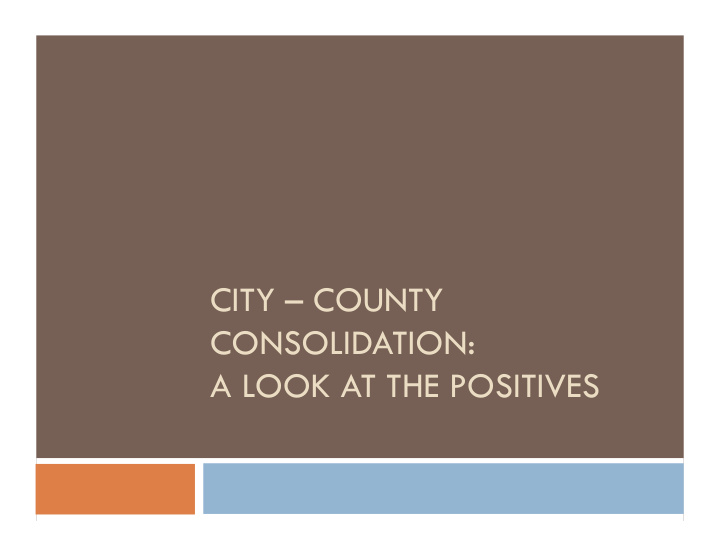



CITY – COUNTY CONSOLIDATION: A LOOK AT THE POSITIVES
The Basics Legislative Process in Kansas Commission Citizens • Appoints • Approves Commission • Disapproves • Makes • Vote Recommendation Governor Legislature
The Basics 32 successful consolidations since 1805 Most successes take place in the Southeast Less than 15% of attempts succeed Argument for efficiency Often viewed as politically unfeasible
Wyandotte Co. / Kansas City, KS The premise: shrinking population, high taxes, rising crime rates…a dying community Original Bill died in the Legislature in 1968 Talk of consolidation resurfaced as viable in the 1980s
Wyandotte Co. / Kansas City, KS Annexation not an option County refused to allow annexation of Piper Opportunities for consolidation Began with talk of consolidating specific services Jail Road & Bridge Planning & Zoning Administrative & Support Areas
Wyandotte Co. / Kansas City, KS 1987: Talk of total consolidation with formation of study group by County Commission Disbanded due to lack of citizen support 1994: Citizen Task Force was established with governmental corruption as motivation Led by Kevin Kelley Support from Chamber of Commerce, mayor, city council, League of Women Voters Recommended unified government Second focus on legislative support
Wyandotte Co. / Kansas City, KS Spring1996: Bill 464 passed Kansas state legislature & Formed Consolidation Study Commission Tasked with recommending 1 of 3 options to Governor Bill Graves Full structural consolidation of Wyandotte Co. & KCK Functional consolidation No action Fall 1996:32 public hearings took place on the matter
Wyandotte Co. / Kansas City, KS January 15, 1997: Hearings held in Kansas state legislature with formal presentation to the Governor Consolidation Study Commission recommended option 1 Legislature accepted April 1, 1997: Citizens vote in favor of consolidation by 60% April – September 1997: Transition Team was established and started transition process
Wyandotte Co. / Kansas City, KS September 9, 1997: Elections for Unified Commission October 1, 1997: Unified Government Commission was sworn into office August 1998: Unified Commission adopted budget and new organizational structure January 1, 1999: Unified Government is fully functional
Wyandotte Co. / Kansas City, KS Why it worked Accelerator Event Scandal involving public official or agency Community emergency Criticism of government by distinguished, outside source Sudden loss of influential leader Which of these happened in Wyandotte Co. /KCK?
Wyandotte Co. / Kansas City, KS Ah, the Benefits! Stated by Dennis Hays: Population has stabilized Property tax rates cut by more than 10% Single-family housing stats are at record levels Property values are steadily increasing Philanthropic recognition and investment Taxpayers support of school bond issues Reinvestment in the Urban Core New Growth and Development including Kansas Speedway & Tourism District Strength in a single policy-making body
Wyandotte Co. / Kansas City, KS Where would Wyandotte County and Kansas City, Kansas be without consolidation? No one really knows… Speculations Very high taxes People leaving in droves High crime
Concluding Remarks Any questions? Comments?
Sources Hays, Dennis. A Study of Potential Areas of Consolidation in Wyandotte County, Kansas . University of Kansas, 1988. Hays, Dennis. Chronology of Unified Government Consolidation: Wyandotte County/ Kansas City, KS Hays, Dennis. Consolidation Information . Hays, Dennis. Phone Interview. 21 September 2007. Ice, Evan. Memo to County Administrator Craig Weinaug. Leland and Thurmaier. Case Studies of City-County Consolidation . M.E. Sharpe, 2004. Shew, Jameson. Memo to Governor Kathleen Sebelius, Kansas . 26 July 2007
Recommend
More recommend